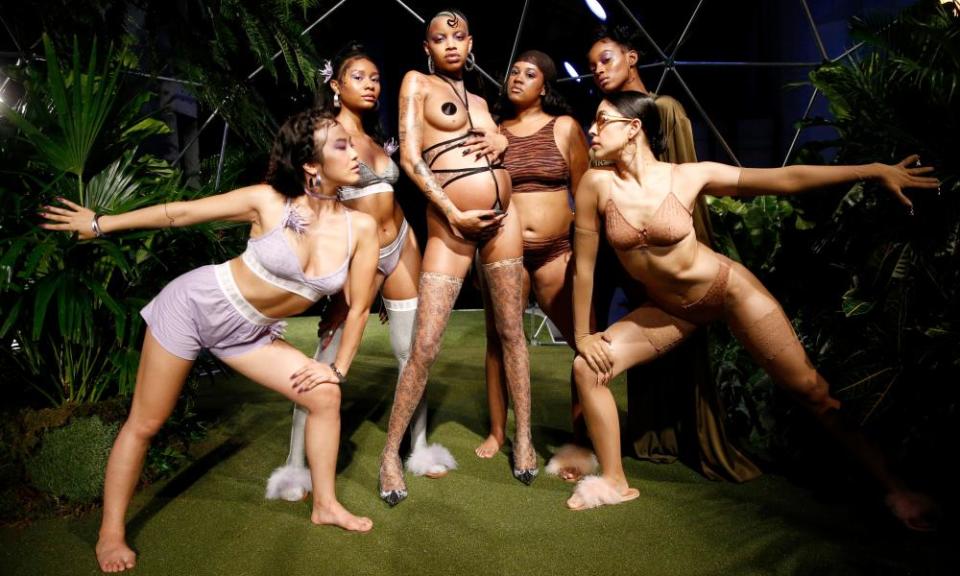'You are more than a body': the lingerie brand that picks models without seeing them
When it comes to fashion models, you may think it’s looks that matter. But, for Maïna Cissé, the founder of lingerie brand the Underargument, stories are the thing. In 2018, Cissé introduced what she calls “anticasting”, a new method to find the models for the images on her site, that could also be described as “blind”. She asks interested parties to submit their stories based on a theme of her collections – which run from the problem of perfectionism to what a loving relationship looks like now. Based only on these written submissions – without seeing images of the women, or any measurements – she casts her next shoot.
This policy feels particularly radical for a lingerie brand, a fashion space typically focused around thin, white bodies, photographed in sexy poses for the male gaze. See everything from Eva Herzigová’s 1994 Hello Boys ad to the more recent Victoria’s Secret shows. Cissé says, for her, it’s about taking the conversation away from bodies, full stop and telling women “that you are more than just a body, and your story is valuable”. While this could sound like marketing speak, the stories themselves are far from it. Naomi speaks out about abuse, Roisin gives her thoughts on gender roles, Mary and Lily discuss polyamory. They all do that while wearing Cissé’s designs. “Everyone looks different, but everyone looks amazing,” says the founder. “We have never met the people before, but we have never had a bad shoot.”
Cissé says she now receives about 50 submissions a week, and shoots every four to six weeks. The casting has helped develop The Underargument. “I started with 10 bra sizes and now I have more than 40,” says Cissé. “I go from 28a to 38e, and I’m working on increasing the sizes of bottoms and bras for next year.” Submissions out of the size range will be included once Cissé has fully developed her range.
Growing up in Normandy and moving to the UK in 2008, Cissé previously worked in marketing. Anticasting grew – in part – as a resistance to that experience. “Being a minority myself … I saw a lot of brands wanting to tick boxes, and wanting to pat themselves on the back because they had chosen models of colour or supposedly bigger or curvier [models] instead of staying in the safe zone,” she says. Such issues are still live in her new career, of course. Cissé tells a story of attending a conference for the lingerie industry where the managing director of a bigger brand said they had “embraced the diversity trend”. “That killed me,” says Cissé, “because people are not trends and minorities are not trends, and people who don’t look like models are not trends.”

There are signs that a more inclusive take on casting is perhaps finally developing in the world of lingerie. In March, Agent Provocateur – a brand that has put a scantily clad Kylie Minogue on a gyrating bull and Kate Moss in a corset – switched to athletes with women such as the gold-medal-winning hurdler Queen Harrison in their campaign. While it might be seen as a cynical ploy to sell bras in a post-#MeToo world, other brands are effecting change. Cissé agrees that Savage x Fenty – launched by Rihanna in 2018, with a show that included plus size models, Joan Smalls and a nine-months-pregnant Slick Woods – has a genuinely “body positive” and diverse point of view. “I don’t think their approach was based on something commercial,” says Cissé. “It was just the way it should be and it made a lot of sense for that brand.” Like The Underargument, Savage x Fenty has been consistent with this diverse casting in their imagery – albeit using professional models rather than casting through submissions.
And, while those professional models won’t be out of a job quite yet, there has been a bit of a casting rethink in other parts of fashion, too. Brands including Eckhaus Latta and Marques’Almeida have consistently used “street casting” with nonprofessional models walking in their catwalk shows. And Theface.com has mooted the idea of the “no-del”. This is based Gucci and Burberry using their own design teams instead of professional models for pre-collections released in July – possibly because, with a pandemic, it’s more tricky to fly Gigi Hadid in for the day.
Burberry’s images feature Massimo, an accessories designer, in a jumper on his doorstep in Hackney and Sabine, from the art direction department, wearing a smart suit in Ladbroke Grove. A more everyday, relatable reality is presented rather than fashion as fantasy. As nice as it is to think this is about big global brands discovering their warm fuzzy side in lockdown, it’s also a savvy shift to the mood of the moment. “Perhaps normies can help us, mere mortals, to connect more emotionally to the clothes,” writes Max Berlinger for Theface.com.
Cissé says that, for her, consistency is the key – for this to work beyond just another fashion “moment”. “I don’t think it should be so obvious to me as a minority that you are trying to tick boxes when you are choosing me,” she says. With The Underargument, she wants to provide a space where women of colour – in particular – can own their narrative. “I always call out for people saying: ‘If you don’t see yourself here, that is one more reason why you should send your story.’” she says. “‘We need to be courageous and be seen – so it becomes the norm.’”

 Yahoo News
Yahoo News 